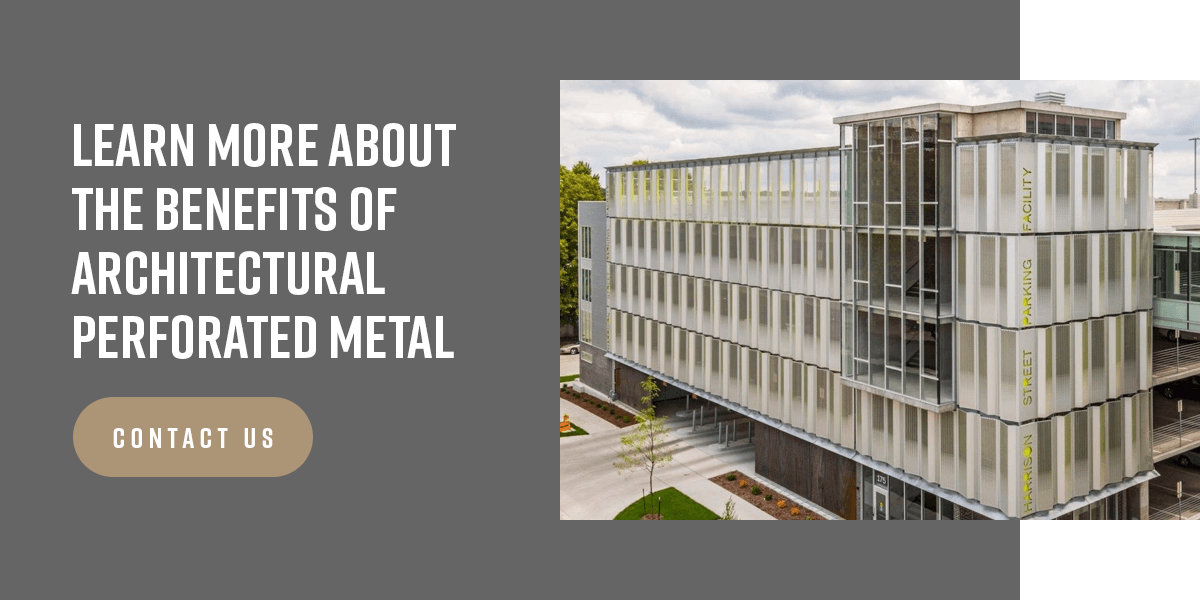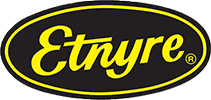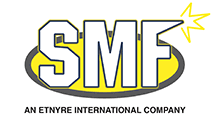Top 6 Benefits of Perforated Metal in Architectural Design
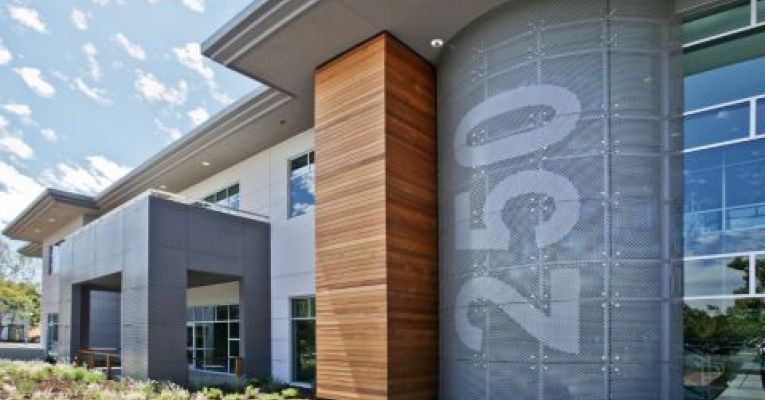
Perforated metal is used for many applications because of its durability, malleability and easy installation and maintenance. Sheet metal improves architectural designs by providing expanded design and functional elements to a building. Plus, it's recyclable and can help you reduce energy bills, making it an economical choice.
This versatile, durable, and attractive material can enhance any building in several key ways.
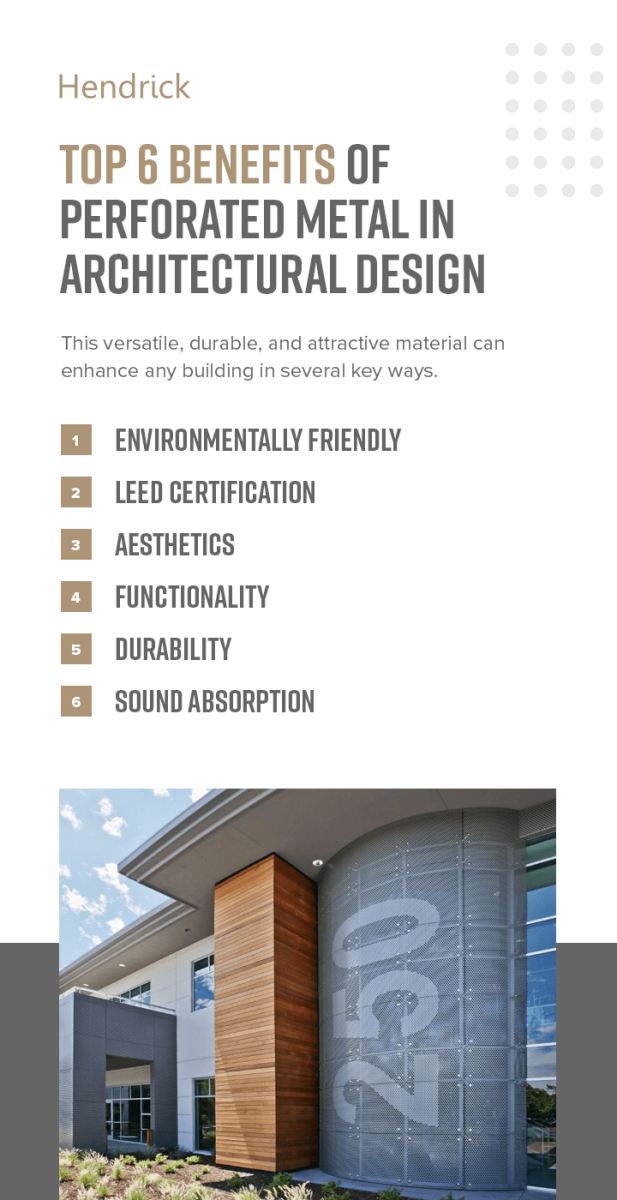
1. Environmentally Friendly
Today's customers care about sustainability, and perforated metal is one of the most environmentally friendly building materials available. Before it even arrives at its destination, sheet metal is lighter than other materials, reducing transportation fuel use. Green choices like using perforated metal can positively reflect on your brand and attract new business.
A lot of sheet metal is made from recycled material and is long-lasting. Scrap metal from the perforations can also be gathered, recycled, and formed into new sheets. The perforations result in less metal used overall, maximizing your resources. You'll also be able to reclaim a piece of metal after its functional architectural lifestyle ends.
Additionally, perforated metal sunscreens and sunshades are energy-efficient. They deflect light, heat, and radiation from the sun while still allowing for ventilation. Buildings experience a more consistent internal temperature while still letting natural light filter inside — all with less energy use to save on utility costs.
With a variety of patterns to choose from, you have some control over the level of sunlight that enters a building. For example, 1/8-inch holes don't permit much light to come through. A building will also have the appearance of a solid wall if the holes are smaller and closer together. It's important to select the correct thickness in addition to proper hole sizes and spacing.
Sunshades can also increase your building's aesthetic appeal with custom designs, multiple colors, and even the ability to implement images and logos into the design.
2. LEED Certification
In addition to its eco-friendly properties, perforated metal can help your buildings become Leadership in Energy in Environmental Design (LEED)-certified. LEED is the most widely used environmental rating system in the world. Through certification, organizations can ensure their buildings are environmentally friendly and cost-effective. Sustainability also helps companies gain a competitive edge, as green buildings improve indoor air quality and attract customers.
The U.S. Green Building Council developed LEED, which rates companies on four levels — basic certification, silver, gold, and platinum. The rating system encourages architects to create sustainable designs and inspires others to follow their lead.
LEED ranks buildings based on the following environmental factors:
Location and transportation options
Water
Energy
Materials and resources
Indoor environmental quality
Becoming LEED-certified can reflect positively on your institution, cut energy costs, and help to preserve the environment. Your building's occupants may also be happier and healthier. The LEED certification criteria reduce harmful chemicals from paints and finishes, improve indoor air quality, and allow for more access to daylight. Using sustainable materials like perforated metal sheets in architectural designs is a key step to gaining certification.
To become LEED-certified, you must register with the U.S. Green Building Council and pay a fee. You should establish a team to manage the certification process and ensure all information is accurate. Each team member should pursue a different LEED factor to reduce oversight. For example, one team member can document a property's water use while another focuses on energy use.
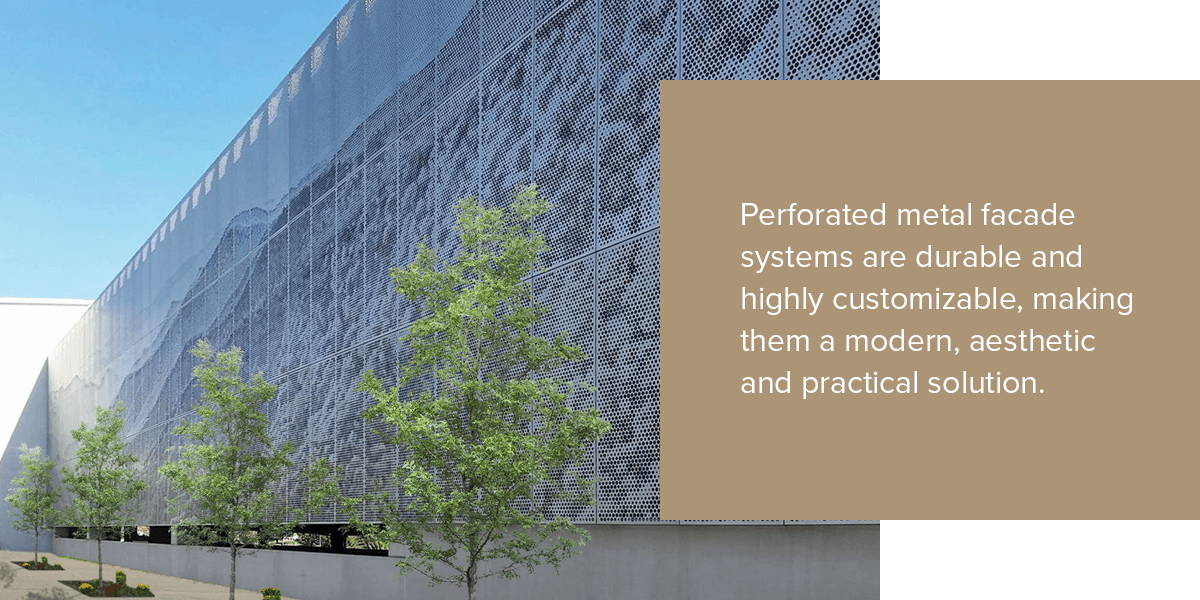
3. Aesthetics
All architectural designers strive to create aesthetic, durable, and functional projects. Perforated metal facade systems are durable and highly customizable, making them a modern, aesthetic and practical solution. The nature of sheet metal allows you to bend it to your desired design easily. With different hole shapes and sizes, thicknesses and finishes, you'll be able to get the custom design you want.
Additionally, you can implement graphics, photographs, logos, or text into your perforated metal panel design to give panels a unique flare. IMAGE-CLAD® perforated imaging panels convert your design into metal images by varying hole size and pattern. Perforated metal signage is a popular application for perforated metal imaging.
Architects also use sheet metal for a variety of other design functions, including:
Perforated facade architecture: Because perforated metal is easy to work with and comes in a range of colors and finishes, it's an excellent choice to give your building a unique flair. For example, you can use unique hole patterns to create eye-catching patterns, like branches.
Suspended ceilings: Perforated metal is an alternative to traditional ceiling tiles that can increase a space's visual appeal. They're effective at covering unattractive overhead systems like AC units and are easy to install and remove. Maintenance workers will have better access to pipelines, wires, or HVAC units. Plus, perforated metal has soundproofing characteristics.
Stair treads and risers: Using perforated sheet metal for stair treads and risers is an aesthetic and functional design choice, especially for outdoor staircases. The holes prevent slips by letting the rain and snow travel through. The material also has greater slip resistance and durability than alternatives. Perforated metal is also an excellent option for stair risers, providing distinctive design options. In industrial settings, the holes can prevent the dark and dreary feeling sometimes associated with staircases by allowing light to filter through.
Infill panels: Indoor and outdoor perforated panels can add some life to an otherwise bland space. Infill panels also provide an element of privacy, filtration, and sound control without completely sectioning off an area.
You can customize and protect your sheet metal with surface finishing. Sheet metal finishing provides even more design opportunities to add color and increase durability. Hendrick Architectural offers the following metal finishing services to improve both the durability and aesthetic appeal of perforated metal facade systems:
Powder coating: Powder coating adds color to your design but is much harder and more durable than regular paint.
Anodizing: This technique is also frequently used for color application. It increases the surface's natural oxide layer's thickness to make the metal more durable and ready for color or sealant application.
E-coating: Electro-coating, also referred to as electro-painting, uses an electric current to deposit paint or lacquer coating. It reduces corrosion and is especially useful when applying color to difficult-to-reach areas.
Silk screening: Silk screening, also known as sublimating, is an ideal solution for printmaking on perforated metal, as it requires no pressure nor a planar surface to apply.
Kynar®painting: A polyvinylidene fluoride (PVDF), Kynar is an incredibly strong finish that's resistant to heat, smoke, and acids. Kynar finishing increases sheet metal's durability and UV protection while adding a pop of color.
Polishing: Polishing removes abrasions from the surface of metal, leaving it with a smooth, clean, bright finish. Electro-polishing is another option in which the surface is chemically milled.
Deburring: Grinding, drilling, or punching can leave burrs, or unwanted excess materials, on the metal's surface. Deburring removes these imperfections to give the perforated metal a cleaner finish.
Degreasing: As its name suggests, degreasing refers to removing dirt, oil, and grease before finishing.
Plating: Plating refers to putting a thin metal layer on the surface, improving corrosion resistance, paint adhesion, and durability. Plus, it enhances sheet metal's aesthetic appeal. You can better shield radiation, harden objects, and reduce friction with electro-plating.
Passivating: Decreasing the metal's chemical reactivity, passivating makes surfaces more resistant to extreme conditions and protects against corrosion.
Chromating: Chromating can prepare the surface for paint, increase resistance to corrosion, and ensure the surface is electrically conductive.
4. Functionality
Perforated sheet metal is an incredibly versatile substance, providing many functional alternatives to solid materials.
Other uses of perforated sheet metal include:
Filtration: Stainless or galvanized steel and aluminum perforated sheet metal is often used for air and liquid filtration solutions. For example, sheet metal is strong enough to withstand the high pressure and vibrations associated with liquid filtration filters.
Lighting fixtures: Perforated metal modernizes lighting fixtures with a combination of form and function. Differently sized and shaped perforations can direct light with unique perforated patterns.
Shelving and displays: Retail locations rely on lightweight, sturdy perforated metal shelving and rack solutions to display or store products. Perforated metal is an excellent option for industrial and retail shelving, gondola walls, and hospital storage.
Security screens: Perforated metal provides high levels of privacy in architectural designs. The nature of the material makes it hard for people to look in, while those inside a building can still see out. Security screens are ideal for facilities like schools, hospitals, prisons, or retail units where safety and security are a priority. They can also help protect buildings from vandalism and other destruction.
Perforated metal facade systems are increasing in popularity for architectural designs, giving buildings a sleek, modern look. Perforated metal provides many color, thickness, and finishing options and is more durable and resistant to abrasions than painted surfaces. Architects typically include interior sheet metal for architectural designs when creating surfaces and partitions.
One beneficial application of perforated metal panels is dividing a room to provide increased privacy without using a solid wall to close the space completely. Using perforated panels as dividers provides an element of privacy while still ensuring a room feels like a connected whole. Plus, enhanced airflow due to the perforations can reduce HVAC costs.
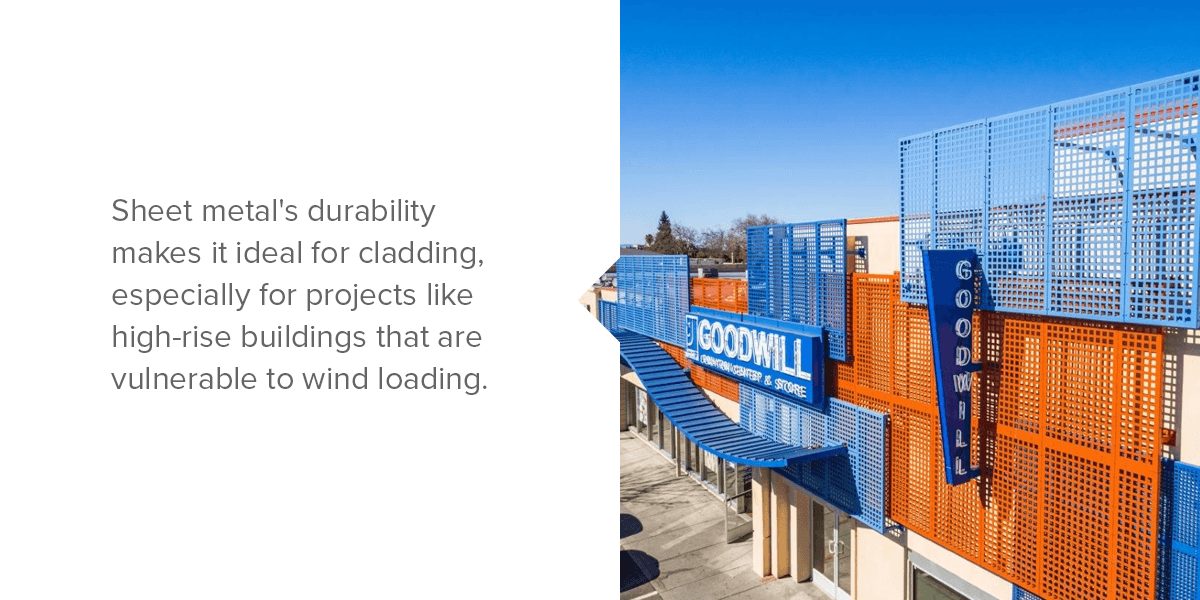
5. Durability
Perforated sheet metal is more durable than alternative building materials. It's more resistant to weather and provides enhanced structural support due to its high strength-to-weight ratio. Plus, the perforations reduce the overall weight the building's framework needs to support. Sheet metal can withstand harsh climates and is long-lasting. You'll spend less money on repairs and replacements over time.
Sheet metal's durability makes it ideal for cladding, especially for projects like high-rise buildings that are vulnerable to wind loading. Perforated metal is more effective than other materials at equalizing pressure between the panel and building.
Metal sheets are often made of these durable materials:
Aluminum: Perforated aluminum sheet metal is one of the widely used materials for sustainable building. It's resistant to corrosion and highly malleable. Hendrick Architectural's H-CLAD exterior cladding system uses aluminum panels to protect buildings from the elements and reduce energy use.
Rolled steel: Both hot- and cold-rolled steel are economical, strong, and versatile. Cold-rolled steel has tight tolerances and a clean appearance, while hot-rolled steel provides loose tolerances and a rough surface.
Stainless steel: Stainless steel is corrosion-resistant and strong, making it an excellent choice for exterior perforated metal facade systems, especially in coastal regions where moisture could be a factor.
Galvanized steel: Galvanized steel is less expensive than stainless steel and resists rust with a protective zinc coating.
Copper and brass: Copper and brass are attractive, malleable, and corrosion-resistant. Further, both materials have long life spans.
Nickel-copper alloys: Nickel-copper alloys can withstand high levels of heat, and they're corrosion-resistant.
Sheet metal finishing enhances durability while providing an aesthetic element. Powder coating and anodizing add color, increase durability, and protect sheet metal from the elements. On the other hand, methods like polishing, deburring, and degreasing give products a smooth, industrial finish. Plus, metal finishing gives products higher resistance to electricity, chemicals, and corrosion.
6. Sound Absorption
Perforated metal is also frequently used to create acoustic panels for noise control. Noise control products and systems — whether for noise reduction or simply acoustic control — primarily consist of perforated metal. Perforated metal can protect an acoustic material like a speaker while still allowing the sound waves to travel through.
On the other hand, perforated metal architectural designs provide some solace from the sound in busy, noisy environments. The varying hole sizes, locations, and thicknesses can be designed to target various sound ranges. The perforations will control how the air moves in response to different frequencies. Panels also absorb sound waves to lower noise, protect occupants' hearing, and reduce stress.
For example, libraries can use perforated metal facade systems to mitigate sound travel. Perforated metal designs can also reduce echo in large, open rooms or areas with high-vaulted ceilings like gymnasiums or concert halls. Other industries that leverage perforated metal architectural designs for sound control include transportation, HVAC, restaurants, and recording studios.
Learn More About the Benefits of Architectural Perforated Metal
For 145 years, Hendrick Manufacturing has provided metal perforating and fabricating solutions for a range of industries. We're capable of utilizing a multitude of different decorative perforation designs. Our high-speed CNC punching capabilities offer accuracy down to 0.004 inches, while laser cutting can help you get a smooth, extremely precise custom perforation design. Contact us today to find a representative near you or request a quote.


